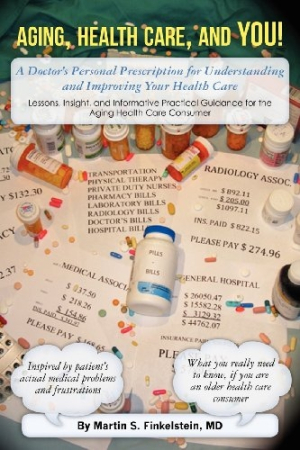Aging, Health Care, and You!
A Doctor's Personal Prescription for Understanding and Improving Your Health Care
This book demystifies health care for older generations grappling to keep up.
Americans spend thousands of dollars trying to stay young, but instead of focusing on health, many of us zero in on our wrinkles. Martin S. Finkelstein’s Aging, Health Care, and You! provides practical advice for seniors who want to understand the aging process, from genes and life expectancy to debunking common stereotypes and dealing with common ailments.
Finkelstein’s book is divided into three main sections. The first explains the mechanics of aging. Finkelstein uses his thirty-seven years of experience in geriatric medicine to explain why seniors deal with strange body odors, hearing loss, and the fact that people can’t breathe as deeply in their seventies as they could in their twenties. The second section explains how aging Americans cope with medical problems that are an extension of earlier issues. For example, a knee problem intensifies over time. Aging becomes easier to understand because the author discusses the realities of ulcers, thinning hair, and “the curse of constipation.” Finally, the third section helps older patients choose doctors, understand health insurance, and communicate effectively when making care decisions or deciphering test results.
Since most elders only receive a handful of minutes with their assigned doctor, it is important to ask the right questions. The book also fills in the gaps so that seniors understand how to manage back pain or deal with hair loss. When the elderly were young, health insurance and doctor visits were different from today: physicians made house calls and everything was paper-based, not electronic. Finkelstein’s book demystifies health care for older generations grappling to keep up.
Medical bills and health insurance documents often seem like they are written in a foreign language. Finklestein defines important concepts like normal variation and normal distribution so seniors can better understand test results. The language is accessible so that readers can understand that results are rarely identical. Billing and medical coding are often confusing. Finkelstein breaks down bills to explain different departments, tests, and procedures. By offering practical advice like using spreadsheets, the author makes bills less intimidating. The book reminds seniors that they should ask when they are in doubt.
Long paragraphs are sometimes overwhelming. Breaking sections into shorter chunks would make it easier to understand the “shadow of cancer” or how to deal with common infections or “ugly lesions.” In addition, Finkelstein might have ended sections with checklists to help people better understand how to manage common situations or issues. As many seniors know, choosing a health insurance plan can be confusing. Adding a chapter focused on different plans and types of coverage would have made it easier to understand changing policies and laws.
Fearing age is counterproductive. Finkelstein reminds people that the key to life is to enjoy it. Understanding how the body changes with time helps older Americans make smart decisions about their care. The age-old Boy Scout motto, “be prepared,” rings true. This book is a prescription for people who want to understand common medical problems and improve their quality of life.
Reviewed by
Lisa Bower
Disclosure: This article is not an endorsement, but a review. The publisher of this book provided free copies of the book and paid a small fee to have their book reviewed by a professional reviewer. Foreword Reviews and Clarion Reviews make no guarantee that the publisher will receive a positive review. Foreword Magazine, Inc. is disclosing this in accordance with the Federal Trade Commission’s 16 CFR, Part 255.

